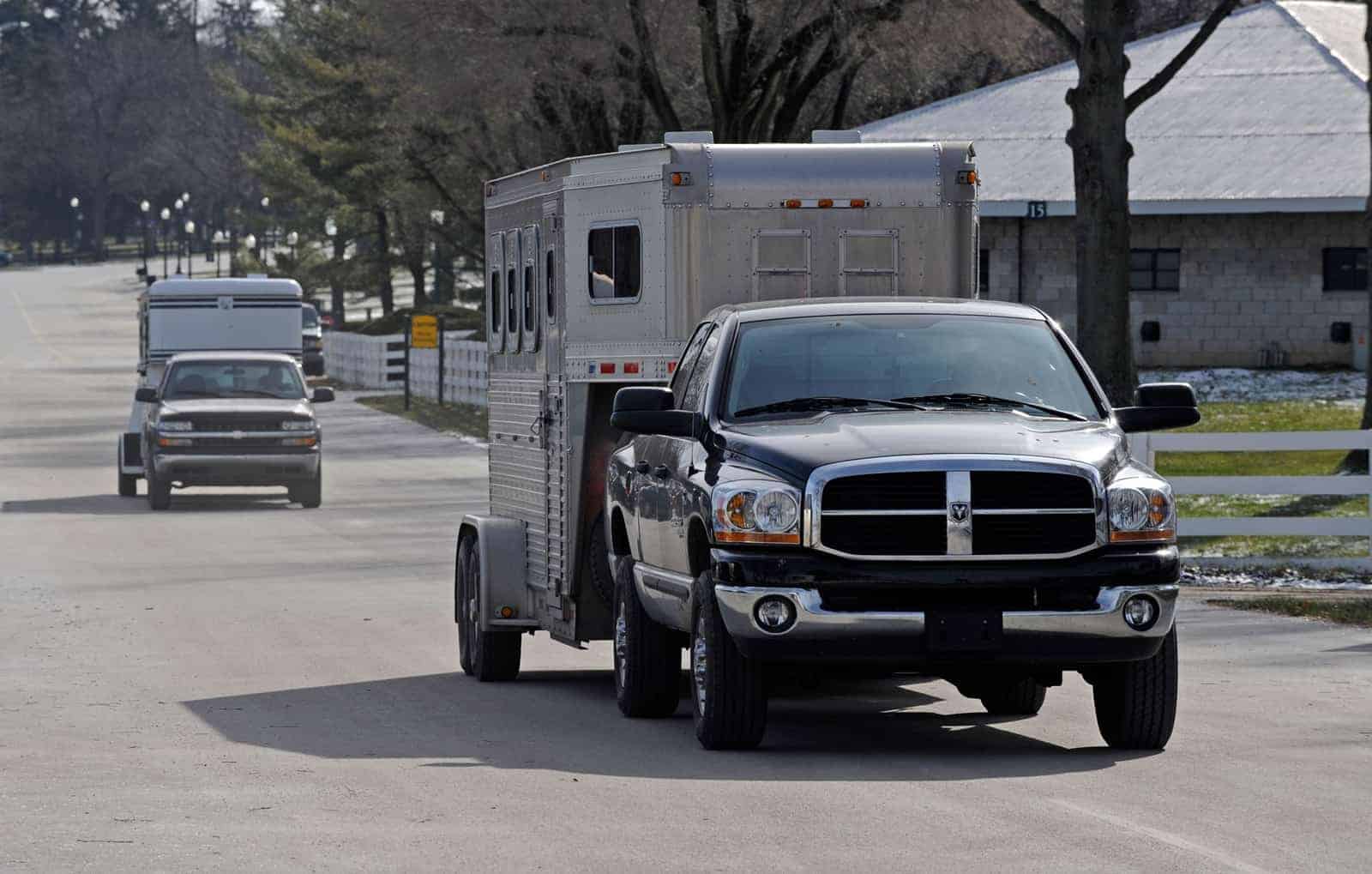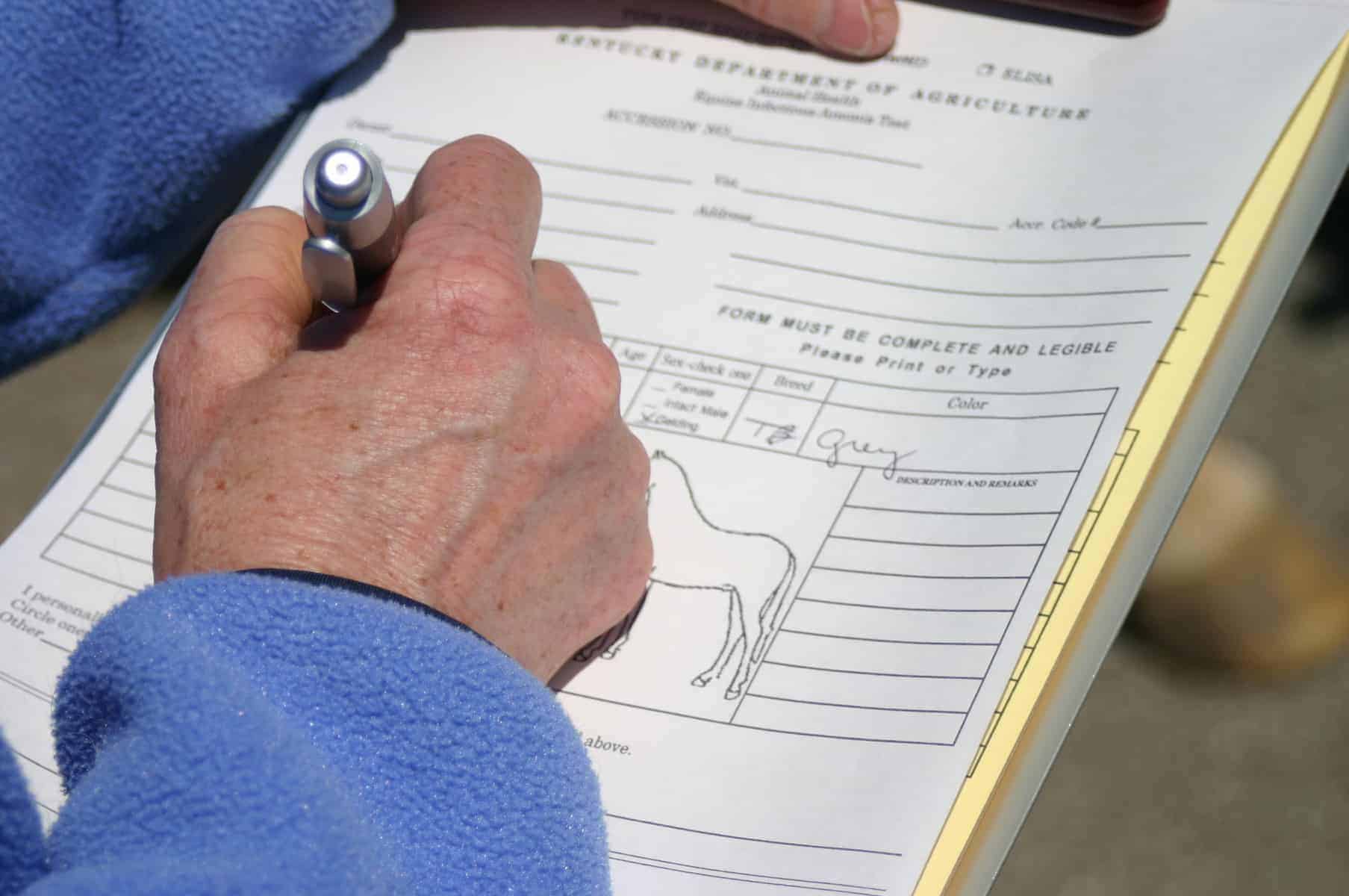State Travel Requirements
- Topics: Article, Business Management, Horse Care, Recordkeeping, Transportation

Who to call and what papers to gather before heading to an out-of-state event with your horse
After months of conditioning and training, you and your horse are ready to head to a horse show. You have cleaned your tack. You have stocked the horse trailer with feed, hay, and supplies. You’ve had your truck and trailer inspected and they are ready for the trip. But aren’t you missing something? Whether you are traveling to another city or another state, you have to make sure your horse’s health papers and vaccinations are up-to-date and adequate for the event or show. These requirements range from the expected to the exotic, depending on your destination, so it’s important that you do the necessary research—and act on it—in enough time to be prepared for your trip.
At least one month prior to the event, check with:
- The State Veterinarian’s Office in the Department of Agriculture of your destination state. You must determine the state’s equine travel regulations, as individual entry requirements vary by location.
- The website of the event you wish to attend. Most competition organizers post regional or additional health requirements for exhibitors. Otherwise, call or e-mail the show coordinator with any questions you might have.
- Your local veterinarian. Discuss with him or her all of the information you have gathered, and request additional vaccinations or health papers if needed.
Gathering Paperwork: State Rules
Officials at most every event or show will ask to see a copy of your horse’s current negative Coggins test and/or a certificate of veterinary inspection (CVI). The Coggins test is the most commonly used means of detecting whether a horse harbors equine infectious anemia (EIA) virus, which causes the incurable blood-borne infectious disease (transmitted through transfer of blood, generally by way of biting flies or shared syringes). Proof of a negative EIA test performed at an accredited laboratory is required for entry into all 50 states. Some states require a negative Coggins test dated within the past year, while others require a negative test within six months.
The CVI attests that your horse exhibited no obvious signs of disease on the day of inspection. These certificates are generally good for 30 days, though some expire in just 10 days. Many neighboring states have formed reciprocal livestock health arrangements so people who travel frequently with their horses between the states can obtain an “equine passport” or equine interstate event permit (EIEP). Horse owners in the mid-Atlantic states and the South, for instance, have the option of getting an EIEP that is good for six months and includes 15 states, from Texas to Virginia, as well as New York. Horse owners in the western United States can obtain a six-month CVI and EIEP for travel between Oregon, California, Idaho, Montana, Nevada, and Washington. Some states also require an entry or import permit, which is usually good for the life of the CVI.

More exotic destinations, such as Hawaii, are free of certain diseases, and state officials might require that the CVI includes additional information beyond the usual free-of-disease status. The Aloha State, for instance, requires a negative Coggins dated within 90 days of shipment, and imported horses must be retested for EIA 45-60 days after entry, says Ashley M. Stokes, DVM, PhD, the University of Hawaii’s extension veterinarian. State veterinary officials also require that the CVI be issued within seven days prior to shipping.
“Make sure you contact the State Veterinarian’s office for the most current regulations well in advance of your travel, so you are well-prepared and don’t hit any snags upon arrival,” says Stokes. It’s crucial that shippers have the original CVI on hand, as many states do not accept copies.
Securing all of the proper paperwork might seem like an added and stressful burden before a long trip. But these animal transport requirements are in place to protect your horse’s health and well-being by helping prevent, control, and hopefully eradicate disease. Such regulations have protected the U.S. equine industry from dissemination of foreign animal diseases such as vesicular stomatitis and piroplasmosis. The rules help improve traceability of livestock, including horses, so veterinary officials can track contagious diseases more efficiently to their sources and, thus, minimize disease effects on horses (more on this in a moment).
Getting Vaccinated
Before you leave, make sure your horse is up-to-date on all vaccinations, especially those considered core. The American Association of Equine Practitioners (AAEP) defines core vaccinations as those “that protect from diseases that are endemic to a region, those with potential public health significance, required by law, virulent/highly infectious, and/or those posing a risk of severe disease.”Effective vaccinations are available for many equine diseases. A “standard” vaccination program for all horses does not exist; therefore, have your veterinarian evaluate your individual situation.
Before traveling, inquire about additional risk-based vaccinations your horse might need—both for his own protection and to meet state entry CVI requirements. Such preventive efforts can be key factors in minimizing disease outbreaks, as well as disease spread.
The Big Picture: USDA Rules
The USDA’s Animal and Plant Health Inspection Service (APHIS) has its own requirements governing horse transport. Horses are considered livestock under the Animal Health Protection Act, which gives APHIS the authority to develop and enforce these rules. Most of the regulations govern interstate transport of cattle, swine, and poultry and are intended to protect our nation’s food supply. However, because some contagious diseases can be devastating to farms, horses, and other livestock, APHIS has included equine transport in the rules. Under USDA federal regulations, which became effective March 1, 2013, horses traveling outside their state of origin must be: 1) identified prior to transport; and 2) accompanied by an Interstate Certificate of Veterinary Inspection (ICVI) or other state-approved document.
Traceability is a critical tool in minimizing a contagious disease’s financial impact. In the event of an outbreak, officials will use these required documents to trace horses that have been at the site of the outbreak as well as other horses that have come into contact with them.
“The horse industry has been dramatically affected by serious disease outbreaks in the last 10 years, which have halted or restricted the movement of horses and the commerce surrounding the horses,” the USDA reports. “Animal disease traceability, or knowing where diseased and at-risk animals are, where they’ve been, and when, is very important to ensure a rapid response when animal disease events take place. An efficient and accurate animal disease traceability system helps reduce the number of animals involved in an investigation, reduces the time needed to respond, and decreases the cost to producers and the government.”
Find Contact Information For
- State animal health officials at the U.S. Animal Health Association website
- View more information on APHIS regulations and the “Traceability for Livestock Moving Interstate Final Rule“
The USDA regulations are built on methods of identification and transport documentation that are already fairly standard and widely employed in the horse industry, such as written descriptions, digital photographs, brands, tattoos, electronic identification methods, and the ICVIs described. The person or entity responsible for moving a horse interstate must ensure they have an ICVI or other USDA-required document. New regulations also give state animal health officials the discretion to approve other methods of movement documentation, which might include a negative Coggins test, an event passport, an owner-shipper statement, or a brand certificate.
As of 2013, USDA rules exclude the following animals:
- Horses used as transportation (horseback, horse and buggy) for travel to another location that return directly to the original location;
- Horses moved from a farm or stable for veterinary treatment that are returned to the same location without change in ownership;
- Horses moved directly from a location in one state through another state to a second location in the original state; and
- Horses moved between shipping and receiving states with another form of identification or documentation other than an ICVI (e.g., a negative Coggins test, as agreed to by animal health officials in the shipping and receiving states or tribes).
Although they can be confusing, inter- and intrastate health requirements for horses fortunately do not change much from year to year. Veterinary officials can implement new or temporary restrictions, however, on short notice.
“Frequently, due to the nature of diseases flaring up and down throughout the course of a given year, and as health emergencies occur, states may implement temporary import restrictions,” says Idaho State Department of Agriculture (ISDA) Division of Animal Industries deputy state veterinarian Scott R. Leibsle, DVM, Dipl. ABVP.
Officials could adopt such restrictions because the disease has a short incubation period or because the magnitude of the disease outbreak is small. These restrictions might include acquiring CVIs as near as possible to horses’ dates of departure, in hopes that veterinarians could detect potentially infected animals prior to transport. During a major health crisis, such as an equine herpesvirus or strangles outbreak, show officials might be forced to require a 48/72-hour CVI.
Take-Home Message
To recap: At least one month prior to your trip, be sure to familiarize yourself with and take care of all equine-related travel requirements. Remember, it is the owner or authorized agent’s responsibility to present complete, legible, and original documentation that meets the destination state’s health requirements.
Any disease outbreak that occurs might lead to officials establishing additional travel requirements, so make the appropriate calls to check on this before you leave home.
Complying with all of a state’s regulations helps protect your horse and the horses he comes in contact with and also lays a solid paper trail. After all of your months of hard work and preparation, you and your horse deserve a productive and enjoyable horse show that isn’t overshadowed by quarantines or disease threats!
Written by:
Nan K. Huff, PhD
Related Articles
Stay on top of the most recent Horse Health news with












